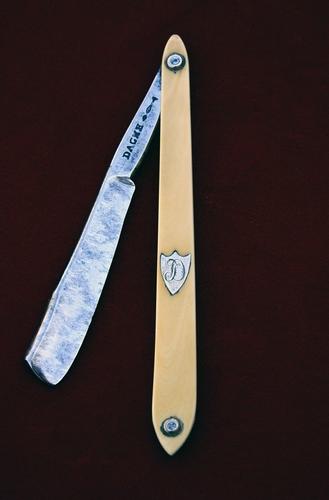Results 31 to 40 of 170
-
06-13-2017, 02:55 PM #31

The story continues here:
https://historyrazors.wordpress.com/...8th-century-2/,
were more examples are shown
-
06-13-2017, 09:09 PM #32

maybe a stupid question, but in a razor of that style if the edge isn't even with the heel is that hone wear?
-
06-13-2017, 09:16 PM #33
-
-
06-14-2017, 08:44 AM #34
-
06-05-2018, 05:00 PM #35
-
The Following User Says Thank You to lohar For This Useful Post:
Fikira (06-06-2018)
-
06-06-2018, 04:38 PM #36
-
06-14-2018, 01:00 PM #37

I looked at the (Pipe)Lindley razor closely and it has a dip but that is almost unseen from hone wear:

~RichardBe yourself; everyone else is already taken.
- Oscar Wilde
-
10-09-2018, 05:41 PM #38Junior Member

- Join Date
- Oct 2018
- Posts
- 19
Thanked: 25
Just joined up to perform a bit of thread necro...
Regarding the pipe and dart, as mentioned it was originally registered to "one Bradshaw" in 1698. Typically marks were registered when someone was granted freedom/freedman status.
The Cutlers Company of Hallamshire shows a William Bradshaw apprenticed to Anthony Coumb in 1688 and freed in 1698. So "one Bradshaw" is William Bradshaw.
Marks were seldom traded either passing with their originator or, in some cases, being reserved for the originator's son.
William Bradshaw had a son (also William) who apprenticed to John Hoole (a cutler) and was granted freedman status in 1730, 1752, and 1755 (not uncommon for multiple occurrences). The multiple entries for being granted freedom _may_ be explained by his not taking his freedom until the passing of his father...1755 would not be an unreasonable timeframe for that.
The last granting listed matches the timeframe for a dip-at-toe razor...and the mark matches the description of the mark granted to his father.
The most likely takeaway from all of this is that the pipe and dart dip-at-toe razors were produced by William Bradshaw in or after 1755.
For how long after 1755, look to his father's date of freedman status: 1698. Typically a family would be started after apprenticeship, so let's assume that William the Second was born sometime around 1700-1710. That would make him ~20-30 years old when first being offered freedman status...and 45-55 years old when finally taking it (and taking on his father's mark). It is unlikely that William the Second would continue in the trade much past 70 years of age, so a reasonable window for manufacture of a dip-at-toe pipe and dart razor would be 1755-1770.
-
The Following 4 Users Say Thank You to srsimon For This Useful Post:
782sirbrian (10-10-2018), Fikira (10-09-2018), Geezer (10-10-2018), MikeT (10-13-2018)
-
10-09-2018, 08:45 PM #39Junior Member

- Join Date
- Oct 2018
- Posts
- 19
Thanked: 25
Quick followup, with a bit more detail and a more likely genealogy:
John Bradshaw apprenticed to Roger Osgathorpe in 1620. One of his sons (William) apprenticed to Anthony Coumb of Crookesmoor in 1688, gaining his freedom and registering the pipe and dart mark in 1698.
William had multiple sons, all continuing the cutlery trade: William (apprenticed to John Hoole, first granted freedom in 1730), Joseph (apprenticed to Robert Hoole in 1717, granted freedom in 1726), Christopher (apprenticed to his father and granted freedom in 1732), and Matthew (apprenticed to his father and granted freedom in 1737).
William was offered his freedom from John Hoole multiple times (first in 1730), only taking it in 1755. William had a son, Robert, who apprenticed to his uncle Christopher in 1740. Robert was granted his Freedom in 1749.
Christopher Bradshaw had a son Joseph who he apprenticed. Joseph was granted his Freedom in 1762. It also appears that Christopher got busy later in life and had another son George
who he apprenticed and granted his Freedom in 1780. This would have Christopher Bradshaw as an active cutler from 1732 - 1780 (at least).
Joseph had a son James who he apprenticed and granted his Freedom in 1770 and a son Matthew who he apprenticed and granted his Freedom in 1776.
And the list goes on. There appears to be a Bradshaw family cutlery operation in place in the Crookeside area of Sheffield from 1698 into the early 1800s. 1814 is the last Freedom date for a Bradshaw in the Crookeside area that I can find a record for (Joseph's son, also named Joseph).
So, answering the earlier question about what happened to the pipe and dart mark between the years 1698 and the contest over it in the mid-1800s, it looks like it stayed in the Bradshaw family...never moving from their cutlery business in the Crookeside area of Sheffield.
This doesn't help narrow the date range of the dip-at-toe straight with the pipe and dart mark...but it's certainly likely that it was made in the proscribed time period (1760s). Almost certainly made by the Bradshaws (not the Linleys/Lindleys).
-
The Following 4 Users Say Thank You to srsimon For This Useful Post:
782sirbrian (10-10-2018), Fikira (10-09-2018), Geezer (10-10-2018), MikeT (10-13-2018)
-
10-09-2018, 10:23 PM #40

This is amazing!
I will take time to study, it looks very promosing!
Thank you very much for this!
May I use this together with your references for my articles?


 317Likes
317Likes LinkBack URL
LinkBack URL About LinkBacks
About LinkBacks






 Reply With Quote
Reply With Quote




